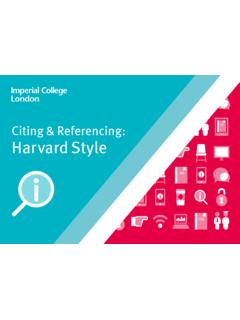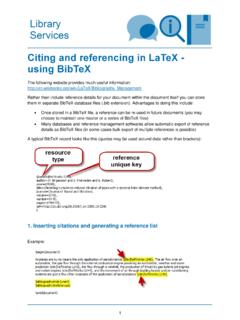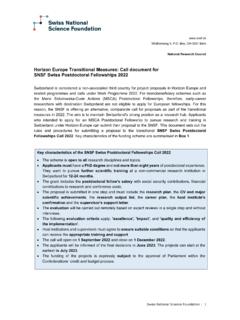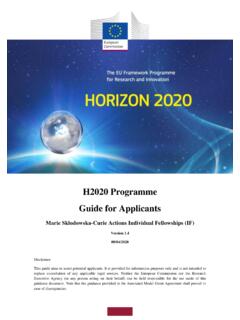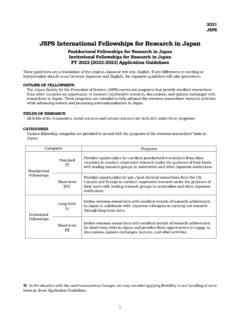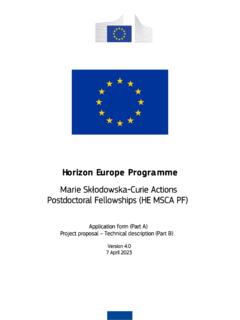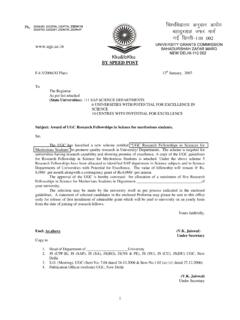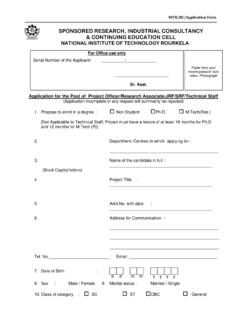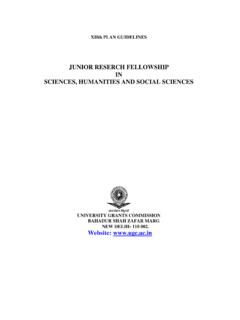Transcription of Report 9: Impact of non-pharmaceutical interventions (NPIs ...
1 16 March 2020 imperial college COVID-19 Response Team DOI: Page 1 of 20 Report 9: Impact of non-pharmaceutical interventions (NPIs) to reduce COVID-19 mortality and healthcare demand Neil M Ferguson, Daniel Laydon, Gemma Nedjati-Gilani, Natsuko Imai, Kylie Ainslie, Marc Baguelin, Sangeeta Bhatia, Adhiratha Boonyasiri, Zulma Cucunub , Gina Cuomo-Dannenburg, Amy Dighe, Ilaria Dorigatti, Han Fu, Katy Gaythorpe, Will Green, Arran Hamlet, Wes Hinsley, Lucy C Okell, Sabine van Elsland, Hayley Thompson, Robert Verity, Erik Volz, Haowei Wang, Yuanrong Wang, Patrick GT Walker, Caroline Walters, Peter Winskill, Charles Whittaker, Christl A Donnelly, Steven Riley, Azra C Ghani. On behalf of the imperial college COVID-19 Response Team WHO Collaborating Centre for Infectious Disease Modelling MRC Centre for Global Infectious Disease Analysis Abdul Latif Jameel Institute for Disease and Emergency Analytics imperial college London Correspondence: Summary The global Impact of COVID-19 has been profound, and the public health threat it represents is the most serious seen in a respiratory virus since the 1918 H1N1 influenza pandemic.
2 Here we present the results of epidemiological modelling which has informed policymaking in the UK and other countries in recent weeks. In the absence of a COVID-19 vaccine, we assess the potential role of a number of public health measures so-called non-pharmaceutical interventions (NPIs) aimed at reducing contact rates in the population and thereby reducing transmission of the virus. In the results presented here, we apply a previously published microsimulation model to two countries: the UK (Great Britain specifically) and the US. We conclude that the effectiveness of any one intervention in isolation is likely to be limited, requiring multiple interventions to be combined to have a substantial Impact on transmission. Two fundamental strategies are possible: (a) mitigation, which focuses on slowing but not necessarily stopping epidemic spread reducing peak healthcare demand while protecting those most at risk of severe disease from infection, and (b) suppression, which aims to reverse epidemic growth, reducing case numbers to low levels and maintaining that situation indefinitely.
3 Each policy has major challenges. We find that that optimal mitigation policies (combining home isolation of suspect cases, home quarantine of those living in the same household as suspect cases, and social distancing of the elderly and others at most risk of severe disease) might reduce peak healthcare demand by 2/3 and deaths by half. However, the resulting mitigated epidemic would still likely result in hundreds of thousands of deaths and health systems (most notably intensive care units) being overwhelmed many times over. For countries able to achieve it, this leaves suppression as the preferred policy option. We show that in the UK and US context, suppression will minimally require a combination of social distancing of the entire population, home isolation of cases and household quarantine of their family members. This may need to be supplemented by school and university closures, though it should be recognised that such closures may have negative impacts on health systems due to increased 16 March 2020 imperial college COVID-19 Response Team DOI: Page 2 of 20 absenteeism.
4 The major challenge of suppression is that this type of intensive intervention package or something equivalently effective at reducing transmission will need to be maintained until a vaccine becomes available (potentially 18 months or more) given that we predict that transmission will quickly rebound if interventions are relaxed. We show that intermittent social distancing triggered by trends in disease surveillance may allow interventions to be relaxed temporarily in relative short time windows, but measures will need to be reintroduced if or when case numbers rebound. Last, while experience in China and now South Korea show that suppression is possible in the short term, it remains to be seen whether it is possible long-term, and whether the social and economic costs of the interventions adopted thus far can be reduced. SUGGESTED CITATION Neil M Ferguson, Daniel Laydon, Gemma Nedjati-Gilani et al.
5 Impact of non-pharmaceutical interventions (NPIs) to reduce COVID-19 mortality and healthcare demand. imperial college London (16-03-2020), doi: This work is licensed under a Creative Commons Attribution-NonCommercial-NoDerivatives International License. 16 March 2020 imperial college COVID-19 Response Team DOI: Page 3 of 20 Introduction The COVID-19 pandemic is now a major global health threat. As of 16th March 2020, there have been 164,837 cases and 6,470 deaths confirmed worldwide. Global spread has been rapid, with 146 countries now having reported at least one case. The last time the world responded to a global emerging disease epidemic of the scale of the current COVID-19 pandemic with no access to vaccines was the 1918-19 H1N1 influenza pandemic. In that pandemic, some communities, notably in the United States (US), responded with a variety of non-pharmaceutical interventions (NPIs) - measures intended to reduce transmission by reducing contact rates in the general population1.
6 Examples of the measures adopted during this time included closing schools, churches, bars and other social venues. Cities in which these interventions were implemented early in the epidemic were successful at reducing case numbers while the interventions remained in place and experienced lower mortality overall1. However, transmission rebounded once controls were lifted. Whilst our understanding of infectious diseases and their prevention is now very different compared to in 1918, most of the countries across the world face the same challenge today with COVID-19, a virus with comparable lethality to H1N1 influenza in 1918. Two fundamental strategies are possible2: (a) Suppression. Here the aim is to reduce the reproduction number (the average number of secondary cases each case generates), R, to below 1 and hence to reduce case numbers to low levels or (as for SARS or Ebola) eliminate human-to-human transmission.
7 The main challenge of this approach is that NPIs (and drugs, if available) need to be maintained at least intermittently - for as long as the virus is circulating in the human population, or until a vaccine becomes available. In the case of COVID-19, it will be at least a 12-18 months before a vaccine is available3. Furthermore, there is no guarantee that initial vaccines will have high efficacy. (b) Mitigation. Here the aim is to use NPIs (and vaccines or drugs, if available) not to interrupt transmission completely, but to reduce the health Impact of an epidemic, akin to the strategy adopted by some US cities in 1918, and by the world more generally in the 1957, 1968 and 2009 influenza pandemics. In the 2009 pandemic, for instance, early supplies of vaccine were targeted at individuals with pre-existing medical conditions which put them at risk of more severe disease4. In this scenario, population immunity builds up through the epidemic, leading to an eventual rapid decline in case numbers and transmission dropping to low levels.
8 The strategies differ in whether they aim to reduce the reproduction number, R, to below 1 (suppression) and thus cause case numbers to decline or to merely slow spread by reducing R, but not to below 1. In this Report , we consider the feasibility and implications of both strategies for COVID-19, looking at a range of NPI measures. It is important to note at the outset that given SARS-CoV-2 is a newly emergent virus, much remains to be understood about its transmission. In addition, the Impact of many of the NPIs detailed here depends critically on how people respond to their introduction, which is highly likely to vary between countries and even communities. Last, it is highly likely that there would be significant spontaneous changes in population behaviour even in the absence of government-mandated interventions . 16 March 2020 imperial college COVID-19 Response Team DOI: Page 4 of 20 We do not consider the ethical or economic implications of either strategy here, except to note that there is no easy policy decision to be made.
9 Suppression, while successful to date in China and South Korea, carries with it enormous social and economic costs which may themselves have significant Impact on health and well-being in the short and longer-term. Mitigation will never be able to completely protect those at risk from severe disease or death and the resulting mortality may therefore still be high. Instead we focus on feasibility, with a specific focus on what the likely healthcare system Impact of the two approaches would be. We present results for Great Britain (GB) and the United States (US), but they are equally applicable to most high-income countries. Methods Transmission Model We modified an individual-based simulation model developed to support pandemic influenza planning5,6 to explore scenarios for COVID-19 in GB. The basic structure of the model remains as previously published. In brief, individuals reside in areas defined by high-resolution population density data.
10 Contacts with other individuals in the population are made within the household, at school, in the workplace and in the wider community. Census data were used to define the age and household distribution size. Data on average class sizes and staff-student ratios were used to generate a synthetic population of schools distributed proportional to local population density. Data on the distribution of workplace size was used to generate workplaces with commuting distance data used to locate workplaces appropriately across the population. Individuals are assigned to each of these locations at the start of the simulation. Transmission events occur through contacts made between susceptible and infectious individuals in either the household, workplace, school or randomly in the community, with the latter depending on spatial distance between contacts. Per-capita contacts within schools were assumed to be double those elsewhere in order to reproduce the attack rates in children observed in past influenza pandemics7.


